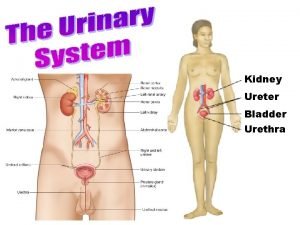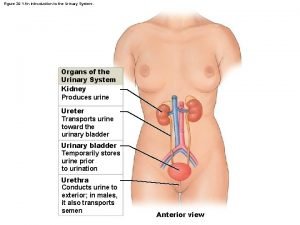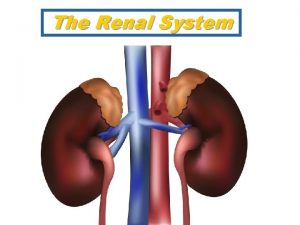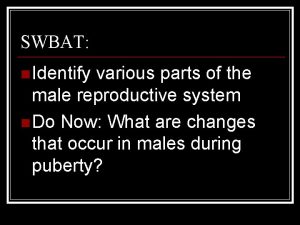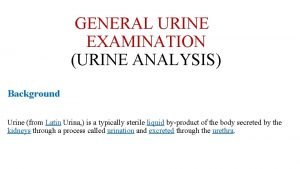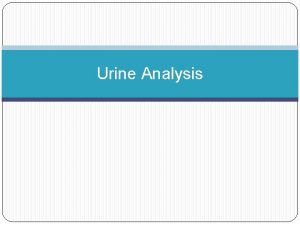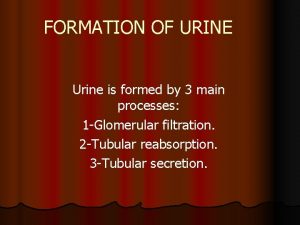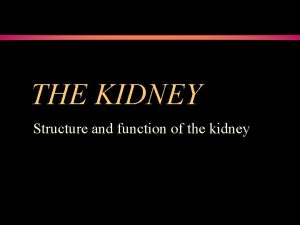Kidney Structure Function and Urine formation CLASS I






















- Slides: 22

Kidney – Structure, Function and Urine formation CLASS: I M. Sc. , UNIT: 5 PREPARED BY: A. BENNO SUSAI

PHYSIOLOGIC ANATOMY OF THE KIDNEYS The two kidneys lie on the posterior wall of the abdomen, outside the peritoneal cavity. Each kidney of the adult human weighs about 150 grams and is about the size of a clenched fist. The medial side of each kidney contains an indented region called the hilum through which pass the renal artery and vein, lymphatics, nerve supply, and ureter, which carries the final urine from the kidney to the bladder, where it is stored until emptied. The kidney is surrounded by a tough, fibrous capsule that protects its delicate inner structures.

Kidney


If the kidney is bisected from top to bottom, the two major regions that can be visualized are the outer cortex and the inner region referred to as the medulla. The medulla is divided into multiple coneshaped masses of tissue called renal pyramids. The base of each pyramid originates at the border between the cortex and medulla and terminates in the papilla, which projects into the space of the renal pelvis, a funnelshaped continuation of the upper end of the ureter.

The outer border of the pelvis is divided into open-ended pouches called major calyces that extend downward and divide into minor calyces, which collect urine from the tubules of each papilla. The walls of the calyces, pelvis, and ureter contain contractile elements that propel the urine toward the bladder, where urine is stored until it is emptied by micturition.

THE NEPHRON IS THE FUNCTIONAL UNIT OF THE KIDNEY Each kidney in the human contains about 1 million nephrons, each capable of forming urine. The kidney cannot regenerate new nephrons. Therefore, with renal injury, disease, or normal aging, there is a gradual decrease in nephron number. After age 40, the number of functioning nephrons usually decreases about 10 per cent every 10 years; thus, at age 80, many people have 40 per cent fewer functioning nephrons than they did at age 40. This loss is not life threatening because adaptive changes in the remaining nephrons allow them to excrete the proper amounts of water, electrolytes, and waste products.


Nephron Each Nephron contains (1) a tuft of glomerular capillaries called the glomerulus, through which large amounts of fluid are filtered from the blood, and (2) a long tubule in which the filtered fluid is converted into urine on its way to the pelvis of the kidney

The glomerulus contains a network of branching and anastomosing glomerular capillaries that, compared with other capillaries, have high hydrostatic pressure (about 60 mm Hg). The glomerular capillaries are covered by epithelial cells, and the total glomerulus is encased in Bowman’s capsule. Fluid filtered from the glomerular capillaries flows into Bowman’s capsule and then into the proximal tubule, which lies in the cortex of the kidney.

From the proximal tubule, fluid flows into the loop of Henle, which dips into the renal medulla. Each loop consists of a descending and an ascending limb. The walls of the descending limb and the lower end of the ascending limb are very thin and therefore are called the thin segment of the loop of Henle. After the ascending limb of the loop has returned partway back to The cortex, its wall becomes much thicker, and it is referred to as the thick segment of the ascending limb.

At the end of the thick ascending limb is a short segment, which is actually a plaque in its wall, known as the macula densa. The macula densa plays an important role in controlling nephron function. Beyond the macula densa, fluid enters the distal tubule, which, like the proximal tubule, lies in the renal cortex. This is followed by the connecting tubule and the cortical collecting tubule, which lead to the Cortical collecting duct.

The initial parts of 8 to 10 cortical collecting ducts join to form a single larger collecting duct that runs downward into the medulla and becomes the medullary collecting duct. The collecting ducts merge to form progressively larger ducts that eventually empty into the renal pelvis through the tips of the renal papillae. In each kidney, there about 250 of the very large collecting ducts, each of which collects urine from about 4000 nephrons.

Differences in Nephron Structure: Cortical and Juxtamedullary Nephrons. Those nephrons that have glomeruli located in the outer cortex are called cortical nephrons; they have short loops of Henle that penetrate only a short distance into the medulla. About 20 to 30 per cent of the nephrons have glomeruli that lie deep in the renal cortex near the medulla and are called juxtamedullary nephrons. These nephrons have long loops of Henle that dip deeply into the medulla, in some cases all the way to the tips of the renal papillae.

Urine Formation (1) Glomerular filtration, (2) Reabsorption of substances from the renal tubules into the blood, and (3) Secretion of substances from the blood into the renal tubules. Urinary excretion rate = rate Filtration rate - Reabsorption rate + Secretion


Urine formation begins when a large amount of fluid that is virtually free of protein is filtered from the glomerular capillaries into Bowman’s capsule. Most substances in the plasma, except for proteins, are freely filtered, so that their concentration in the glomerular filtrate in Bowman’s capsule is almost the same as in the plasma. As filtered fluid leaves Bowman’s capsule and passes through the tubules, it is modified by reabsorption of water and specific solutes back into the blood or by secretion of other substances from the peritubular capillaries into the tubules.


GLOMERULAR FILTRATION—THE FIRST STEP IN URINE FORMATION Urine formation begins with filtration of large amounts of fluid through the glomerular capillaries into Bowman’s capsule. Like most capillaries, the glomerular capillaries are relatively impermeable to proteins, so that the filtered fluid (called the glomerular filtrate) is essentially protein-free and devoid of cellular elements, including red blood cells.

Almost one half of the plasma calcium and most of the plasma fatty acids are bound to proteins, and these bound portions are not filtered through the glomerular capillaries


REFERENCE • Arthur C. Guyton, 2005, Text Book of Medical Physiology, WB Saunders’s, USA. • C. C Chatterjee, 1985, Human Physiology Vol I & Vol II. 11 th. Edn, Kalyani Mukerjee Publications, Kolkata, India. • Kathleen, J. W. Wilson and Anne Waugh. 1998. Ross and Wilson Anatomy and Physiology in health and illness. (8 th Edition). Churchchill Livingstone, New York. • Gerald J. Tortora and Sandra Reynolds. 2003. Principles of Anatomy and Physiology. (10 th Edition). John Wiley and Sons. Inc. Pub. New York. • Abraham White. , Philip Handler and Emil L. Smith. 1983. Principles of Biochemistry. (6 th Edition). Tata Mc Graw – Hill Publishing Company, New Delhi.
 Pictures of white particles in urine
Pictures of white particles in urine Function of urinary bladder
Function of urinary bladder Dari hasil tes urine ternyata urine pak
Dari hasil tes urine ternyata urine pak Regulation of kidney function class 11
Regulation of kidney function class 11 Urinary system introduction
Urinary system introduction Reabsorption and secretion in renal tubules
Reabsorption and secretion in renal tubules Urine formation
Urine formation Urine formation
Urine formation Urine formation video
Urine formation video Human excretory system diagram class 10
Human excretory system diagram class 10 Non excretory function of kidney
Non excretory function of kidney 7 functions of the kidney
7 functions of the kidney Histological structure of kidney
Histological structure of kidney Figure 26-2 the nephron
Figure 26-2 the nephron Formation initiale vs formation continue
Formation initiale vs formation continue Kidney system
Kidney system Cortex and medulla of kidney
Cortex and medulla of kidney Dr claire gibbons
Dr claire gibbons N
N Bulbourethral gland functions
Bulbourethral gland functions Acute fulminating preeclampsia
Acute fulminating preeclampsia Normal constituents of urine
Normal constituents of urine Crenation
Crenation

